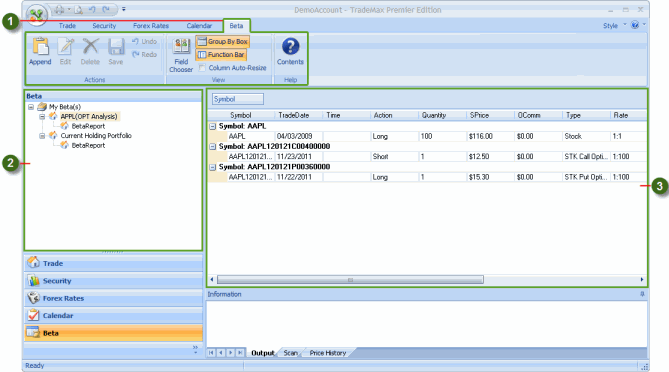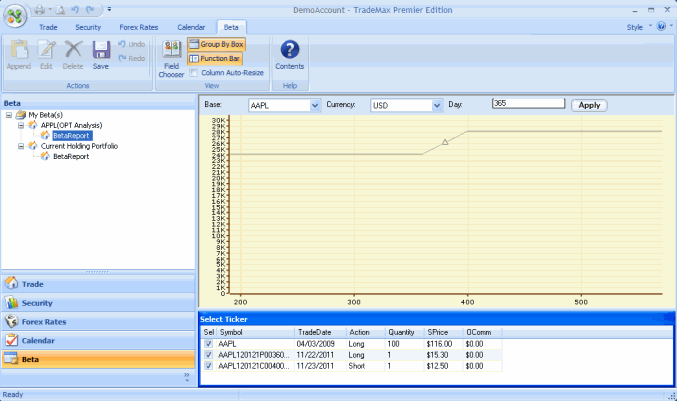 |
BUY CALL
WHEN TO USE. You are very bullish on the stock. The more bullish you are, the higher the strike should be. No other position gives you so much leveraged advantage with limited downside risk.
PROFIT increases as stock rises. At expiration, break-even point will be option strike A plus premium paid. For each point above break-even, profit increases by an additional point.
LOSS is limited to the premium paid. Maximum loss realized if the stock ends below A. For each point above A, loss decreases by additional point.
RISK: Limited. REWARD: Unlimited. MARGIN: Not required.
TIME DECAY. This position is a wasting asset. As time passes, value of position erodes toward expiration value. If volatility increases, erosion slows; if volatility decreases, erosion speeds up. |
|
|
BUY PUT
WHEN TO USE. You are very bearish on stock. The more bearish you are, the more out-of-the-money (lower strike) should be the option you buy. No other position gives you as much leveraged advantage in a falling stock (with limited upside risk).
PROFIT increases as stock falls. At expiration, break-even point will be option exercise price A less premium paid. For each point below break-even, profit increases by additional point.
LOSS limited to amount paid for option. Maximum loss is realized if the stock ends above option exercise A. For each point below A, loss decreases by additional point.
RISK: Limited. REWARD: Unlimited.
TIME DECAY This position is a wasting asset. As time passes, value of position erodes toward expiration value. If volatility increases, erosion slows; if volatility decreases, erosion speeds up. |
|
|
SELL NAKED PUT
WHEN TO USE. You are sure that the price will not fall. Sell lower strike options if you are only somewhat convinced; sell higher strike options if you are very confident the stock will stagnate or rise. If you doubt stock will stagnate, sell at-the-money options for maximum profit.
PROFIT: limited to the premium received from sale. At expiration, break-even point is strike price A less premium received. Maximum profit realized if stock settles at or above A.
LOSS: increases as stock falls. At expiration, losses increase by one point for each point stock is below break-even. Because the risk is open-ended, this position must be watched closely.
RISK: Unlimited. REWARD: Limited. MARGIN: Always required.
TIME DECAY: this position is a growing asset. As time passes, value of position increases as option loses its time value. Maximum rate of increasing profits occurs if the option is at-the-money. |
|
|
BULL SPREAD
Call option is bought with a strike price of A and another call option sold with a strike of B, producing a net debit.
OR
Put option is bought with a strike of A and another put sold with a strike of B, producing a net credit.
WHEN TO USE: you think the stock will go up somewhat or at least is a bit more likely to rise than to fall. Good position if you want to be in the stock but are unsure of bullish expectations. This is the most popular bullish strategy.
PROFIT: limited, reaching maximum if stock ends at or above the higher strike B at expiration. If call spread used, difference between strikes minus initial debit. If put spread used, net initial credit.
LOSS: maximum loss if stock at expiration is at or below A. If call spread used, maximum loss is net initial debit. If put spread, difference between strikes minus initial credit.
RISK: limited. REWARD: limited.
TIME DECAY: if stock is midway between A and B, no time effect. At B, profits increase at fastest rate with time. At A, losses increase at maximum rate with time. |
 |
BEAR SPREAD
Put option is bought with a strike price of A and another put option sold with a strike of B, producing a net debit.
OR
Call option is bought with a strike of A and another call sold with a strike of B, producing a net credit.
WHEN TO USE: you think the stock will go down somewhat or at least is a bit more likely to fall than to rise. Good position if you want to be in the stock but are unsure of bearish expectations. This is the most popular bearish strategy.
PROFIT: limited, reaching maximum if stock ends at or below the lower strike B at expiration. If put spread used, difference between strikes minus initial debit. If call spread used, net initial credit.
LOSS: maximum, if stock at expiration is at or above A. If put spread used, maximum loss is net initial debit. If call spread, difference between strikes minus initial credit.
RISK: limited. REWARD: limited.
TIME DECAY: if the stock is midway between A and B, no time effect. At A,profits increase at fastest rate with time. At B, losses increase at maximum rate with time. |
 |
SELL COVERED CALL
Call option against the stock holding is sold.
WHEN TO USE: you are sure that the price of the stock you hold will not fall. Sell lower strike options if you are only somewhat convinced; sell higher strike options if you are confident stock will rise. If you think stock will stagnate, sell at-the-money options for maximum profit.
PROFIT: limited to the strike minus the market price plus the premium received.
LOSS: similar to that incurred with ordinary stock ownership, only partially off-set by the option premium received. Main loss could be the opportunity loss if the market rises strongly.
RISK: unlimited. REWARD: limited.
TIME DECAY: This position is a growing asset. As time passes, value of position increases as the option loses its time value. Maximum rate of increasing profits occurs if option is at-the-money. |
|
BUY STRADDLE
Call option and put option are bought with the same strike A – usually at-the-money.
WHEN TO USE: you firmly believe that the stock moves far enough in either direction in the short-term. Buy higher/lower strike options if the position can encounter different probabilities of bullish or bearish movements of the stock; buy at-the-money options if those probabilities are almost equal.
PROFIT: increases as the stock rises or falls. At expiration, break-even points will be option exercise price A +/- prices paid for options. For each point above upside break-even or below downside break-even, profit increases by an additional point.
LOSS: limited to the amount paid for options. Maximum loss realized if stock ends at option exercise A. For each point above or below A, loss decreases by additional point.
RISK: limited. REWARD: unlimited. MARGIN: not required.
TIME DECAY: This position is a wasting asset. As time passes, value of position erodes toward expiration value. If volatility increases, erosion slows; if volatility decreases, erosion speeds up. |
|
BUY STRANGLE
Put option is bought with a strike A and a call option is bought with a strike B.
WHEN TO USE: you strongly believe the stock will move far enough from the predefined range. This strategy is similar to the buy straddle but the premium paid here is less. Buy higher/lower strike options if the position can encounter different probabilities of bullish or bearish movements of the stock; buy at-the-money options if those probabilities are almost equal.
PROFIT: unlimited andincreases as stock rises above B or falls below A. At expiration, break-even points will be option exercise price A – prices paid for options and option exercise price B + prices paid for options. For each point above upside break-even or below downside break-even, profit increases by an additional point.
LOSS: limited to amount paid for options. Maximum loss realized if stock ends between A and B. For each point above B or below A, loss decreases by additional point.
RISK: limited. REWARD: unlimited. MARGIN: not required.
TIME DECAY: This position is a wasting asset. As time passes, value of position erodes toward expiration value. If volatility increases, erosion slows; if volatility decreases, erosion speeds up. |
|
BUY BUTTERFLY
Call option with low strike bought and two call options with medium strike sold and call option with high strike bought. The same position can be created with puts.
WHEN TO USE: you believe that the stock price will fluctuate in a narrow range.
PROFIT: limited, reaching maximum at a high strike. If call version used, downside break-even=low strike – net cost of spread, upside break-even is at high strike + net cost of spread.
LOSS: maximum loss realized if stock ends below low strike or above high strike and limited to net credit paid. For each point above low strike or below high strike, loss decreases by additional point.
RISK: limited. REWARD: limited.
TIME DECAY: This position is a combined asset. As time passes, value of position increases/erodes toward expiration value. If volatility increases, increase/erosion slows; if volatility decreases, increase/erosion speeds up. |
|
SELL BUTTERFLY
Call option with low strike sold and two call options with medium strike bought and call option with high strike sold. The same position can be created with puts.
WHEN TO USE: you believe that the stock price will move substantially.
PROFIT: limited to initial credit received.
LOSS: limited to the difference between the lower and middle strikes minus the initial spread credit.
RISK: limited. REWARD: limited.
TIME DECAY: This position is a combined asset. As time passes, value of position increases/erodes toward expiration value. If volatility increases, increase/erosion slows; if volatility decreases, increase/erosion speeds up. |
|
BUY CONDOR
The condor takes the body of the butterfly梩wo options at the middle strike梐nd splits it between two middle strikes rather than just one. In this sense, the condor is basically a butterfly stretched over four strike prices instead of three. Call option with low strike bought and two call options with two medium strikes sold and call option with high strike bought. The same position can be created with puts.
WHEN TO USE: you believe that the stock price will fluctuate in a trading range.
PROFIT: limited, reaching maximum between medium strikes.
LOSS: maximum loss realized if stock ends below low strike or above high strike and limited to net credit paid. For each point above low strike or below high strike, loss decreases by additional point.
RISK: limited. REWARD: limited.
TIME DECAY: This position is a combined asset. As time passes, value of position increases/erodes toward expiration value. If volatility increases, increase/erosion slows; if volatility decreases, increase/erosion speeds up. |
|
SELL CONDOR
The condor takes the body of the butterfly梩wo options at the middle strike梐nd splits it between two middle strikes rather than just one. In this sense, the condor is basically a butterfly stretched over four strike prices instead of three. Call option with low strike sold and two call options with medium strikes bought and call option with high strike sold. The same position can be created with puts.
WHEN TO USE: you believe that the stock price will move substantially.
PROFIT: limited to initial credit received.
LOSS: limited to the difference between the lower and middle strikes minus the initial spread credit.
RISK: limited. REWARD: limited.
TIME DECAY: This position is a combined asset. As time passes, value of position increases/erodes toward expiration value. If volatility increases, increase/erosion slows; if volatility decreases, increase/erosion speeds up. |
![]() Screen Shot
Screen Shot






